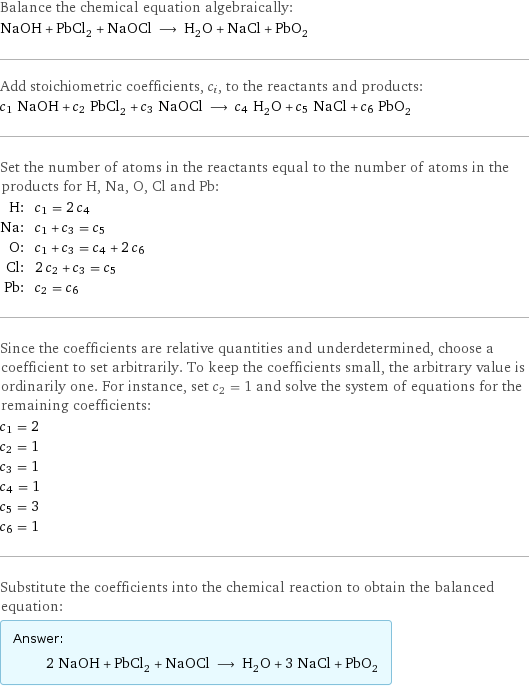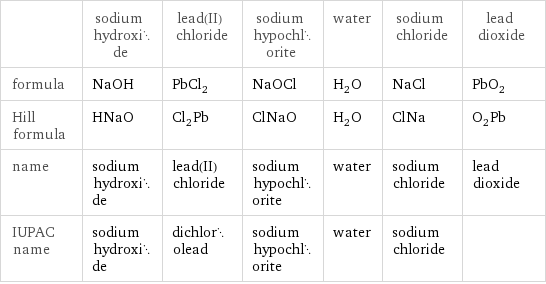Input interpretation

NaOH sodium hydroxide + PbCl_2 lead(II) chloride + NaOCl sodium hypochlorite ⟶ H_2O water + NaCl sodium chloride + PbO_2 lead dioxide
Balanced equation

Balance the chemical equation algebraically: NaOH + PbCl_2 + NaOCl ⟶ H_2O + NaCl + PbO_2 Add stoichiometric coefficients, c_i, to the reactants and products: c_1 NaOH + c_2 PbCl_2 + c_3 NaOCl ⟶ c_4 H_2O + c_5 NaCl + c_6 PbO_2 Set the number of atoms in the reactants equal to the number of atoms in the products for H, Na, O, Cl and Pb: H: | c_1 = 2 c_4 Na: | c_1 + c_3 = c_5 O: | c_1 + c_3 = c_4 + 2 c_6 Cl: | 2 c_2 + c_3 = c_5 Pb: | c_2 = c_6 Since the coefficients are relative quantities and underdetermined, choose a coefficient to set arbitrarily. To keep the coefficients small, the arbitrary value is ordinarily one. For instance, set c_2 = 1 and solve the system of equations for the remaining coefficients: c_1 = 2 c_2 = 1 c_3 = 1 c_4 = 1 c_5 = 3 c_6 = 1 Substitute the coefficients into the chemical reaction to obtain the balanced equation: Answer: | | 2 NaOH + PbCl_2 + NaOCl ⟶ H_2O + 3 NaCl + PbO_2
Structures

+ + ⟶ + +
Names

sodium hydroxide + lead(II) chloride + sodium hypochlorite ⟶ water + sodium chloride + lead dioxide
Equilibrium constant
![K_c = ([H2O] [NaCl]^3 [PbO2])/([NaOH]^2 [PbCl2] [NaOCl])](../image_source/a1c0667da0bc82aff8c6f099f54b2b9c.png)
K_c = ([H2O] [NaCl]^3 [PbO2])/([NaOH]^2 [PbCl2] [NaOCl])
Rate of reaction
![rate = -1/2 (Δ[NaOH])/(Δt) = -(Δ[PbCl2])/(Δt) = -(Δ[NaOCl])/(Δt) = (Δ[H2O])/(Δt) = 1/3 (Δ[NaCl])/(Δt) = (Δ[PbO2])/(Δt) (assuming constant volume and no accumulation of intermediates or side products)](../image_source/4933ca786dd69492169a9c501122cfed.png)
rate = -1/2 (Δ[NaOH])/(Δt) = -(Δ[PbCl2])/(Δt) = -(Δ[NaOCl])/(Δt) = (Δ[H2O])/(Δt) = 1/3 (Δ[NaCl])/(Δt) = (Δ[PbO2])/(Δt) (assuming constant volume and no accumulation of intermediates or side products)
Chemical names and formulas

| sodium hydroxide | lead(II) chloride | sodium hypochlorite | water | sodium chloride | lead dioxide formula | NaOH | PbCl_2 | NaOCl | H_2O | NaCl | PbO_2 Hill formula | HNaO | Cl_2Pb | ClNaO | H_2O | ClNa | O_2Pb name | sodium hydroxide | lead(II) chloride | sodium hypochlorite | water | sodium chloride | lead dioxide IUPAC name | sodium hydroxide | dichlorolead | sodium hypochlorite | water | sodium chloride |
Substance properties

| sodium hydroxide | lead(II) chloride | sodium hypochlorite | water | sodium chloride | lead dioxide molar mass | 39.997 g/mol | 278.1 g/mol | 74.44 g/mol | 18.015 g/mol | 58.44 g/mol | 239.2 g/mol phase | solid (at STP) | solid (at STP) | liquid (at STP) | liquid (at STP) | solid (at STP) | solid (at STP) melting point | 323 °C | 501 °C | -6 °C | 0 °C | 801 °C | 290 °C boiling point | 1390 °C | 950 °C | | 99.9839 °C | 1413 °C | density | 2.13 g/cm^3 | 5.85 g/cm^3 | 1.11 g/cm^3 | 1 g/cm^3 | 2.16 g/cm^3 | 9.58 g/cm^3 solubility in water | soluble | | miscible | | soluble | insoluble surface tension | 0.07435 N/m | | | 0.0728 N/m | | dynamic viscosity | 0.004 Pa s (at 350 °C) | | | 8.9×10^-4 Pa s (at 25 °C) | | odor | | | | odorless | odorless |
Units
